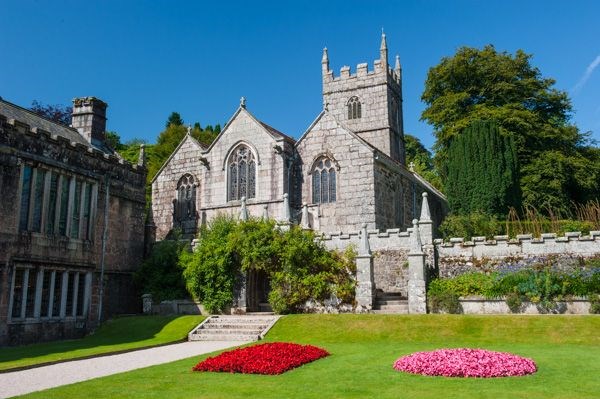GC5FT33

St Hyroc's Church |
The church was built in the mid 15th Century but may incorporate an earlier church or chapel. As early as 1478 Sanctus Ydroc, St Hydroc, was regarded as the church’s patron saint – one of the many Celtic saints who travelled as missionaries between Ireland, Wales, Cornwall and Brittany. The granite cross outside is 13th Century, and there is a Holy Well in the gardens. The porch, with lovely roof timbers, dates to 1546. Two slate tablets, one in English, one in Latin, record the virtues of George Carminow of Polmaugan in the parish of St Winnow and of his wife Jane. Carminow died in 1599. Family tradition says that a Carminow fought against Julius Caesar! Soon after Sir Richard Robartes bought the Estate in 1620 he set about restoring the church. To show his loyalty to the crown he had a plaster panel erected, showing the arms of King James I – one of very few from that reign. There is also a memorial to Lady Essex Robartes, the youngest daughter of John Robartes, First Earl of Radnor, and his second wife, Laetitia-Isavella Smith, one of the great beauties of Charles II’s court. On 9 April 1689 she married John Speccot of Penheale, MP for Newport. They did not even have one day’s happiness, as whilst John did not know it, but he was already infected with smallpox, and rapidly became very ill. He would recover, but Essex had caught the disease and she was not so lucky – she died on 30th April. She was 20. The church was restored 1886-88, funded by Thomas Charles, 2nd Lord Robartes, in memory of his parents Thomas and Juliana who died shortly after the 1881 fire (when the house was largely destroyed). The white alabaster reredos was supplied by Earp and Hobbs of Kensington. The heir was Captain (Tommy), Thomas Agar-Roberts (born in 1880). Before he went to War he went to Oxford, then was MP for Cornwall, described as “the best dressed man in Parliament”. At the start of the War he had volunteered for the Devon Yeomanry, then joined the Royal Bucks Hussars. Finding they were to be stationed in England he joined the Coldstream Guards. On 13 February 1915 he embarked for France. According to a notice in the church he returned from Home Leave with a collection of musical instruments, found musicians to play them, and they accompanied the troops on route marches. On 4 August they were to ‘cover’ the evacuation of the front line, playing (loudly) German favourites like The Watch on the Rhine as the trenches emptied. Tommy advertised this with a poster in German raised above the parapet. The concert was closed by an artillery barrage. The Battle of Loos took place the following month, a battle which saw 20,000 casualties. Tommy was wounded on 28th September, but fought on. During the attack on Hill 70 he first rescued a sergeant, then went back for a wounded private. This was when a sniper picked him off. He died of his wounds on 30th September 1915. There are two memorial crosses/tablets to him in church, and the East Window was a gift from the tenants. |
| Cache Information |
This particular cache has a Virtual Stage and a Final Location. To calculate the Final location you need to find three gravestones in the small churchyard, two are see-through circular Celtic crosses, and the other is a rectangular stone by the tower. A=The first number of the day on which Henry Wood died, B= The number of letters in the surname of the bishop on the metal memorial planting plaque by the main door, C= The second number of the day Henry Wood died, D= The second number of the age of Mary Masters when she died, E= The first number of the age of Mary Masters when she died, F= The day John Lewarne died. The final cache location is at N50 AB.BCD & W004 EA.FCD. |